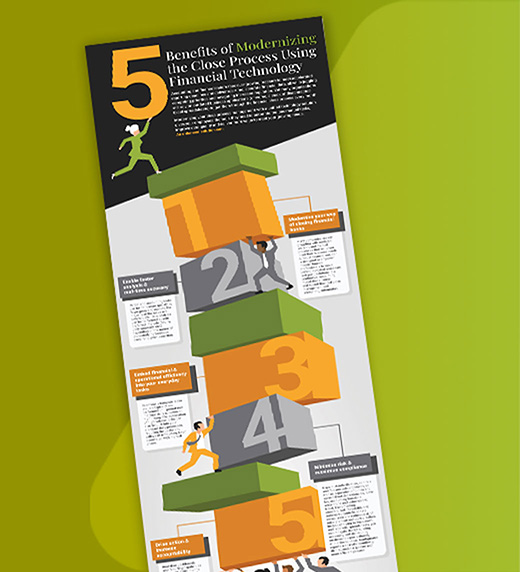
Modernizing your organization’s technology, processes and applications is a valuable way to prepare for future success now and avoid costly mistakes later. However, if you’ve already transformed part or most of your tech stack but are finding that too many areas are still manual, you may be missing a critical piece of the puzzle — extending your digital transformation to your financial close process.
If you’ve already invested in an enterprise resource planning (ERP) system, a customer relationship management (CRM) system or even a corporate performance management (CPM) system, it can be frustrating to realize that your technology ecosystem still isn’t providing you the complete picture you desire. Adding a modernized financial close process with a cloud software solution can help you fill those remaining gaps in five major ways.
Even if your organization has a tech stack, chances are that your close process is still completely manual. Your reconciliations, variance analyses, journal entries and task tracking are all likely maintained in Excel spreadsheets — an inefficient and error-prone strategy — and it’s likely your team is wasting their valuable skills on completing mundane, repetitive tasks. Meanwhile, the pressure is only intensifying to get reporting done faster, more accurately, with fewer resources and better analysis and insights.
Standardizing, automating and centralizing your financial close processes helps alleviate those financial close burdens. Having a cloud-based financial close solution that works alongside your existing accounting systems allows you to remove the last manual barriers in your process flow and meet your reporting deadlines with better information.
Additionally, because a manual close process requires a high degree of labor-intensive accounting tasks, finance and accounting budgets are often inefficiently distributed. Reducing those costs is difficult, especially for businesses growing in complexity. Overhauling key processes allows you to redistribute and drive more value out of your finance budget.
Keeping an antiquated close process in place is holding your business back. The manual month-end close process can take anywhere from 10 to 15 days (whoa!), with team members having to compile, validate and reconcile spreadsheets and re-enter data multiple times into multiple systems. Hitting the wall at every period-end squanders the momentum gathered by the other automating technology you have in place, and it leaves little or no time for data analysis.
Employing a modern financial close solution means that period-end accounting tasks can be done more quickly by fewer people. In our experience, clients have seen a 30 to 40% decrease in the time spent on their monthly close process after employing a modern solution (oh yeah!). With a continuous accounting solution, bottlenecks are eliminated and accountants can reallocate their time to strategic, value-added tasks and minimize late-night number crunching.
For companies manually closing the books every month, spreadsheet errors are common, and mistakes can go undetected until they become full-blown problems. Digging back through data to track down discrepancies can cost even more valuable time, and if a mistake goes unnoticed altogether it could lead to distrust in your financial statement accuracy or even expose you to instances of fraud.
Implementing a modern financial close process gives you visibility into your finances all month long — eliminating the end-of-the-month scramble. A financial cloud solution lets you automatically reconcile millions of transactions each month within minutes and instantly unify intercompany transactions. Balances can be updated in your solution on an ongoing basis, allowing you to keep up with the numbers as they are entered, and standardized workflow and reporting tools keep accounts from being overlooked and ensure that exceptions are immediately addressed.
Business leaders, too, can see profits and losses in real time and make informed decisions daily as circumstances change — instead of receiving a paper report after it’s already too late.
In an increasingly complex regulatory environment, compliance is a crucial component of any integrated tech stack and excluding the close process from your technology ecosystem can put you at risk. Manual close activities like email signoffs can easily spiral into a compliance disaster. When it comes time for an audit, you may have to sort through thousands of emails to get auditors the documentation they need — assuming you can find it at all.
A modern financial close software fills the gaps left behind by even the most sophisticated ERP and CRM systems. An upgraded financial close software has built-in segregation of duties and standardized, repeatable and automated controls that boost and reduce risk of misstatement and control failure. Instead of trying to track down and reconcile spreadsheets, you can mitigate risk by building, accessing and distributing on-demand reports directly within the platform.
When you’re working out of disparate systems, getting a 360-degree view of your data and financials can be difficult. And if you have teams and employees spread across multiple locations and time zones, the lack of transparency into the status and accuracy of data entry tasks is only exacerbated.
Integrating a modern close solution into your current technology stack enables companies to move past legacy record-to-report chaos and implement end-to-end continuous accounting that gives you the full picture of your data and financials. Real-time dashboards and a central repository make all task components easily accessible, process gaps easy to identify and fill and ensure that everyone's recent work is stored and available to the team at all times.
If you find that your current finance technology stack is incomplete, even with recent upgrades, and your team continues to deal with hours of manual work, it may be time to enhance your financial close process. A cloud solution that automates and controls financial close and accounting processes, such as BlackLine, can help you achieve the five benefits outlined above. Upgrading finance technology takes a concerted effort among several stakeholders, but the time spent to properly set up your tech stack will result in a system that serves your business needs, enables your team to reduce regulatory risk and maximizes day-to-day accuracy and efficiency in the long run.
To learn more about how to upgrade your financial close process with automation, tighter controls and increased visibility, contact our experts, we’re ready to help you close the gaps.


